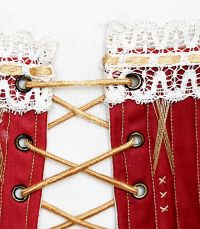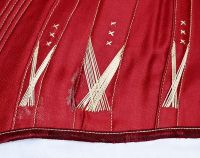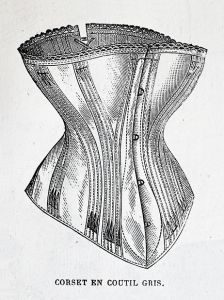1880s Corset
| ||||||||||||||||||
1878-1886 A corset in red coutil.

-
The back of the corset
-
Detail of the top of the back
-
Detail of the lower edge at one side
-
The label printed at the lower edge inside the corset
Description
The corset is mounted on ivory coutil. There are four bones in each half and sections of three cords between them; the bone nearest the centre front has cording each side. At each side there is a steel, ⅝" wide, with a curve over the hips; this has empty bone channels each side. All the stitching is in cream thread.
The spoon busk at the centre front opening has four clips and studs. The back has 14 pairs of eyelets for lacing; the four at the waist are closer together to pull in the waist more tightly. The lace is made of strands of cotton encased in fawn plaited silk threads, which are wearing off in places revealing the cotton core; this may not be original.
The lower edge is bound with wine cotton bias braid, ¼" showing, and the top is trimmed with a strip of double-edged machine-made lace, 1⅜" wide, which has fawn silk plaited braid, ³⁄₁₆" wide, slotted through the middle. Each end of the bone channels has decorative stitching in deep cream silk thread, and also the low points of the bust gussets.
The maker's label is printed at the base of the lining in the right side back; it says: Izod's Patent Moulded Sewn Corsets.
Contemporary illustration
-
Fashion drawing in La Mode Illustrée, September 1877
History
Edwin Izod developed a steam-moulding process in 1868 which continued to be used over the next twenty years. It involved soaking a corset in starch and putting it on a steam-heated copper body shape until it dried. Whalebone, or baleen, can be shaped through heating; the warmth of the body of the wearer has this effect.




